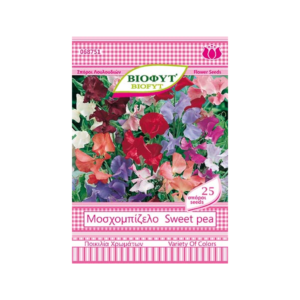Carnation Double
Carnation Double
Carnations grow best in bright and sunny places, where they give us many flowers. It is not afraid of winter and is a cold-resistant plant, as it can withstand sub-zero temperatures. On the contrary, the very hot and dry summers bother her. Temperatures above 35 degrees can weaken the plant and dry it out. The carnation prefers rich, fertile soil with good water drainage, as it is sensitive to excessive moisture and its roots can rot.
Carnations have moderate watering needs. During the spring and autumn, we water the carnation twice a week, while in the winter the watering becomes more sparse. During the summer months and in hot conditions, especially when in small pots, the carnation needs more frequent watering, at least every two days, to cope with the very high temperature levels. Because carnations are sensitive to soil moisture, water only after checking that the soil is dry.
More Products
Passiflora
PassifloraPassiflora, the flower of passion that impresses with its distinctive shape. Passiflora is a climbing plant that grows very quickly and is a beautiful way to cover fences and pergolas. The impressive flower of the passionflower resembles the shape of a clock, which is why in several regions of our country it is known as a clock. Passiflora is native to South America. It can reach a growth of up to ten meters and gives us its wonderful flowering in the summer. There are hundreds of species of Passiflora, most climbing, although there are also some shrubs and trees among them. A well-known species of Passiflora (Passiflora edulis) is our well-known Passion fruit, whose fruits are eaten.
Snapdragon Giant
Snapdragon GiantThe Snapdragon, a favorite ornamental plant with wonderful flowers, is planted in the spring and is a characteristic plant of the Mediterranean, with rich vegetation. We will find Snapdragon in dwarf varieties from 20-40 cm, medium height from 40-60 cm and tall varieties from 60-120 cm. Although a perennial plant, it is usually planted as an annual in gardens and in pots on the balcony to give us rich flowering and impressive color combinations. Snapdragon thrive in full sun, although they can adapt and thrive even in shady areas.
Sweet pea
Sweet peaSweet pea (Lathyrus odoratus, Fabaceae) is a genus of perennial and annual climbing plants native to the south-eastern Mediterranean, Italy, southern France and Greece. The musk pea Lathyrus odoratus is a genus of over thirty perennial and annual aromatic climbing plants, and belongs to the Fabaceae family. It is an annual climbing or erect plant with a height of 60-180 cm and a width of 40-80 cm. The leaves are grey-green, oval 5-7cm long, some have been formed into tendrils for climbing the plant. The flowers of the plant are large, fragrant, butterfly-shaped and grow many together in groups. Creates a rich and deep root system.
Salvia
SalviaSalvia is a perennial herbaceous plant, cultivated as an annual. It is also called “fire” because of the arrangement and crimson color of its flowers. It belongs to the Labiatae family. The genus Salvia includes about 500 species of plants. Among them is the Mediterranean aromatic sage S. officinalis. Many varieties and hybrids have been created including Salvia x superba with its impressive purple-blue flowers. Salvia is native to Brazil and remains in bloom throughout summer and fall. Its decorative value is due to the rich flowering but also to the contrast created by the red flowers with the lively green foliage. It is planted in groups in rock gardens, lawns, flower beds and plant containers, alone or in combination with other annual plants. The combination of salvia and yellow amber is excellent!
Gaillardia
GaillardiaGaillardia is an impressive flower with characteristic green-grey foliage and beautiful flowers that resemble daisies in shades of red, yellow and orange. Gaillardia is characterized by abundant and prolonged flowering that lasts from early summer to mid-autumn. It comes from America and belongs to the same family as the sunflower with several varieties, some annual and others perennial and a height varying between 30-90 cm. Gaillardia is an ideal choice for planting in a flower bed, in a rock garden, as well as in a pot on the balcony. The Gaillardia plant gives a wild flower feel to our garden and is also one of the plants that attract butterflies and birds. Gaillardia needs sunny positions to give us its impressive flowering. It wants light and sandy soil that has good drainage, as young Gaillardia plants are sensitive to excess moisture. To plant it in a pot on the balcony, we prefer places with southern exposure and relatively sheltered, as it is sensitive to low temperatures and strong north winds. In any case, we put a layer of gravel at the base of the pot to drain away the water and not to close the holes of the pot due to soil compression.
Euphorbia
EuphorbiaEuphorbia lactea cristata, is an easy-to-grow succulent, resulting from the grafting of two species. That is, two plants in one! Its upper part is Euphorbia lactea and its color is silver-grey, which can turn reddish if the plant is happy in its environment. Its lower part is usually Euphorbia neriifolia. Its shape resembles a coral and resulted from a normal mutation of Euphorbia lactea and is also known as Coral plant. Prefer bright spots in the growing area. With gradual acclimatization, it can also live in direct sunlight.









